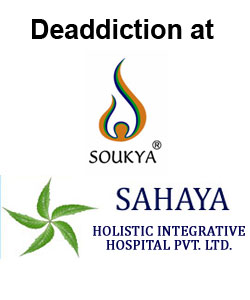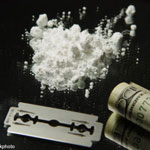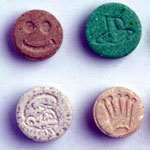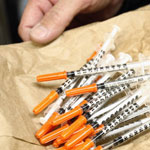DRUG ADDICTION
DRUG ADDICTION is a dependence on an illegal drug or a medication. It is a chronic, relapsing disease characterized by compulsive drug seeking and abuse and by long-lasting chemical changes in the brain. It is a state of being dependent on a substance, which is harmful or dangerous for the physical and/or mental health of the person and for his social and economic well-being. When one is addicted, it may not be able to control your drug use and continue using the drug despite the harm it causes. Drug addiction can cause an intense craving for the drug. One may want to quit, but most people find they can't do it on their own.
For many people, what starts as casual use leads to drug addiction. Drug addiction can cause serious, long-term consequences, including problems with physical and mental health, relationships, employment and the law.
Most drug addictions start with casual or social use of a drug. For some people, using the drug becomes a habit, and its use becomes more and more frequent. As time passes, one may need larger doses of the drug to get high. As the drug use increases, one may find that it becomes increasingly difficult to go without the drug. Stopping may cause intense cravings and physically ill (withdrawal symptoms).
Addiction is a brain disease
All drugs of abuse affect the brain. Though each drug is different, the effects on the brain are common. There is a circuit in the brain called the reward pathway which releases a chemical called dopamine when stimulated. Release of dopamine causes the person to experience pleasure. All addictive substances affect this circuit directly or indirectly.
Different drugs affect the body in different ways, but all drugs chemically alter the brain. The drug effects that occur in individuals who consume drugs depend on how the brain processes the chemicals in each drug. The amount of drugs needed to cause certain effects vary as well. All of an individual's perceptions are controlled by the brain; therefore, the brain dictates the effects of drug abuse in individuals. What a person feels, hears, smells, tastes, thinks, and sees depends on what the brain is communicating to the individual's body. The brain and body have normal functioning patterns and operate according to very specific patterns when a person does not consume substances that cause any type of chemical disruption. However, when chemicals are introduced to the brain, the chemical messengers in the brain are altered, causing the brain to send a different set of signals to the body. Chemicals can cause individuals to see, think, and act very differently than they normally would, which is why drug abuse affects individuals and the world around them
What are drugs of abuse and how do they affect people?
- A drug of abuse refers to any drug that alters mood or body function that can be habit forming or addictive
- People generally use drugs because they like the way drugs make them feel
- Pleasure is a powerful force If one does something pleasurable, the brain is wired in such a way that one wants to do it again.
- A person has control over his/her choice to start using drugs, but once started, the pleasurable effect of drugs makes one want to keep reusing.
- Over time, the brain actually changes in certain ways that the powerful urge to use drugs controls the persons‘behavior.
- This is what it means by addiction.
- Someone who is addicted uses drugs without thinking or caring about the consequences.
- Drugs that alter the mind and behaviour can cause problems even before addiction develops
Why do people start?
Vulnerability to addiction differs from person to person
- Curiosity And Peer Pressure
- Myths About Beneficial Qualities Of Alcohol And Drugs
- Imitation and Learning From Others
How do drugs cause problems?
By their behavioural effects
- intoxication
- removal of inhibition
- impairment of memory
- loss of control over one‘s action
- Tendency to take risks under influence By leading to addiction
Top Substances of Abuse
Alcohol |
|
Cocaine |
|
Crack Cocaine |
|
Crystal Meth |
|
Ecstasy & MDMA |
|
Heroin |
|
Marijuana |
|
Causes: Like many psychological disorders, drug addiction and dependence depends on several things. No single factor determines whether a person will become addicted. The overall risk is influenced by:
- Environment - (e.g., conditions at home, at school, and in the neighborhood) Environmental factors, including family's beliefs and attitudes and exposure to a peer group that encourages drug use, seem to play a role in initial drug use.
- Genes - Once started using a drug, the development into addiction may be influenced by inherited traits.
- Gender
- Ethnicity
- Developmental stage
- Changing brain pathways – Physical addiction appears to occur when repeated use of a drug alters the way brain feels pleasure. The addicting drug causes physical changes to some nerve cells (neurons) in brain. Neurons use chemicals called neurotransmitters to communicate.
Risk factors: People of any age, sex or economic status can become addicted to a drug. However, certain factors can affect the likelihood of your developing an addiction:
- Family history of addiction. Drug addiction is more common in some families and likely involves the effects of many genes. If you have a blood relative, such as a parent or sibling, with alcohol or drug problems, you're at greater risk of developing a drug addiction.
- Being male. Men are twice as likely to have problems with drugs.
- Having another psychological problem. If you have a psychological problem, such as depression, attention-deficit/hyperactivity disorder or post-traumatic stress disorder, you're more likely to become dependent on drugs.
- Peer pressure. Particularly for young people, peer pressure is a strong factor in starting to use and abuse drugs.
- Lack of family involvement. A lack of attachment with your parents may increase the risk of addiction, as can a lack of parental supervision.
- Anxiety, depression and loneliness. Using drugs can become a way of coping with these painful psychological feelings.
- Taking a highly addictive drug. Some drugs, such as heroin and cocaine, cause addiction faster than do others
Drug addiction behaviours in general include:
- Feeling that you have to use the drug regularly — this can be daily or even several times a day
- Failing in your attempts to stop using the drug
- Making certain that you maintain a supply of the drug
- Spending money on the drug, even though you can't afford it
- Doing things to obtain the drug that you normally wouldn't do, such as stealing
- Feeling that you need the drug to deal with your problems
- Driving or doing other risky activities when you're under the influence of the drug
- Focusing more and more time and energy on getting and using the drug.
Signs and symptoms of addiction to drug
- Extreme amounts of energy and an inability to sleep. Cycles of increased activity, restlessness, (This is a sign of someone using stimulants, such as cocaine or methamphetamine.)
- Crashing in cycles, and sleeping excessively when the crashing occurs.
- Failure to maintain physical appearance.
- Failure to fulfill work or family related obligations.
- Sudden weight loss or gain.
- Disappearing for hours, days or even weeks at a time.
- Constant excuse making for disappearances and neglect of responsibilities.
- Stealing money or asking for it without good reason.
- Pawning or selling valuables for money.
- Mood swings and personality changes.
- Expressed anger when accused of drug use.
- Unexpected changes in clothing, such as constantly wearing long sleeved shirts, to hide scarring at injection sites.
- Abnormally slow movements, speech or reaction time, confusion and disorientation. (This is a sign of someone using depressants, such as alcohol, opiates like heroin, benzodiazepines and barbiturates.)
- Drug related smells on clothes and in hair.
- Drug related paraphernalia, such as unexplained pipes, roach clips, syringes, broken lighters and small plastic baggies
- For snorted drugs, chronic troubles with sinusitis or nosebleeds.
- For smoked drugs, a persistent cough or bronchitis, leading to coughing up excessive mucus or blood.
- Severe dental problems (This is a sign of someone using methamphetamine.)
Recognizing signs of Drug Use and Dependence: The particular signs and symptoms of drug use and dependence vary depending on the type of drug.
Marijuana and Hashish
It is possible to develop a psychological addiction to cannabis compounds including tetrahydrocannabinol (THC) found in marijuana and hashish. People who have a marijuana addiction generally use the drug on a daily basis. They don't actually have a chemical dependence on the drug but rather feel the need to regularly use the drug.

Signs of use and dependence can include:
- A heightened sense of visual, auditory and taste perception
- Poor memory
- Increased blood pressure and heart rate
- Red eyes
- Decreased coordination
- Difficulty concentrating
- Increased appetite
- Slowed reaction time
- Paranoid thinking
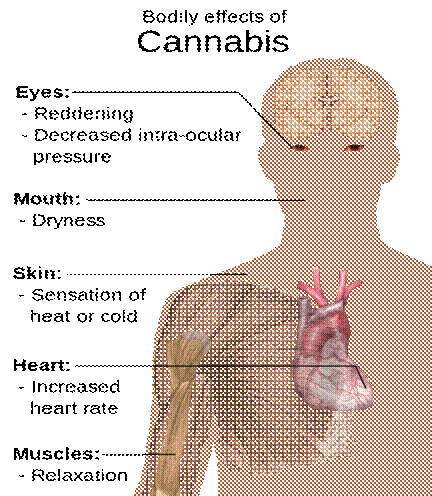
Barbiturates and Benzodiazepines
Barbiturates and benzodiazepines are prescription central nervous system depressants. Phenobarbital, amobarbital (Amytal) and secobarbital (Seconal) are examples of barbiturates. Benzodiazepines include tranquilizers, such as diazepam (Valium), alprazolam (Xanax), lorazepam (Ativan), clonazepam (Klonopin) and chlordiazepoxide (Librium).
Signs of use and dependence can include:
- Drowsiness
- Slurred speech
- Lack of coordination
- Memory problems
- Confusion
- Slowed breathing and decreased blood pressure
- Dizziness
- Depression
Methamphetamine, Cocaine and other stimulants
This class of drugs includes amphetamines, methamphetamine, cocaine and methylphenidate (Ritalin). Methamphetamine, also known as "meth," is a particularly dangerous drug. It's highly addictive and causes a number of short-term and long-term health consequences. Methamphetamine is relatively inexpensive and widely available.
Signs of use and dependence can include:
- Euphoria
- Decreased appetite
- Rapid speech
- Irritability
- Restlessness
- Depression as the drug wears off
- Nasal congestion and damage to the mucous membrane of the nose in users who snort drugs
- Insomnia
- Weight loss
- Increased heart rate, blood pressure and temperature
- Paranoia
Club drugs
Club drugs are drugs commonly used by teens and young adults at clubs, concerts and parties. Examples include Ecstasy (MDMA), GHB, Rohypnol ("roofies") and ketamine. These drugs are not all classified in the same category, but they share some similar effects and dangers.
GHB and Rohypnol are particularly dangerous. At high doses, they can cause seizures, coma and death. The danger increases when these drugs are taken with alcohol. Because they worsen consciousness and memory and they're easy to give someone without his or her knowledge or consent, these drugs are both commonly used as date-rape drugs.
One particular danger of club drugs is that the liquid, pill or powder forms of these drugs available on the street often contain unknown substances that can be harmful, including other illegally manufactured or pharmaceutical drugs.
Signs of club drug use and dependence can include:
- An exaggerated feeling of great happiness or well-being (euphoria)
- Reduced inhibitions
- A heightened or altered sense of sight, sound and taste
- Amphetamine-like effects (with ketamine and Ecstasy)
- Decreased coordination
- Poor judgment
- Memory problems or loss of memory
- Increased or decreased heart rate and blood pressure
- Drowsiness and loss of consciousness (with GHB and Rohypnol)
Hallucinogens
Use of hallucinogens produces different signs and symptoms depending on the drug. The most common hallucinogens are LSD and phencyclidine (PCP).
Signs of LSD use include:
- Hallucinations
- Greatly reduced perception of reality, for example, interpreting input from one of your senses as another, such as hearing colors
- Permanent mental changes in perception
- Rapid heart rate
- High blood pressure
- Tremors
- Flashbacks, a re-experience of the hallucinations — even years later
Signs of PCP use include:
- Hallucinations
- Euphoria
- Delusions
- Panic
- Loss of appetite
- Depression
- Aggressive, possibly violent behavior
Inhalants
The signs and symptoms of inhalant use vary depending on what substance is inhaled. Some commonly inhaled substances include glue, paint thinners, correction fluid, felt tip marker fluid, gasoline, cleaning fluids and household aerosol products.
When inhaled, these products can cause brief intoxication and a decreased feeling of inhibition. Long-term use may cause seizures and damage to the brain, liver and kidneys. Inhalant use can also cause death.
Narcotic Painkillers
Opioids are narcotic, painkilling drugs produced naturally from opium or made synthetically. This class of drugs includes heroin, morphine, codeine, methadone and oxycodone (OxyContin
Signs of narcotic use and dependence can include:
- Reduced sense of pain
- Sedation
- Depression
- Confusion
- Constipation
- Slowed breathing
- Needle marks (if injecting drugs)
Recognizing drug abuse in teenagers
It can sometimes be difficult to distinguish normal teenage moodiness or angst from signs of drug use. Possible indications that a teenager is using drugs include:
- Problems at school. Frequently missing classes or missing school, a sudden disinterest in school or school activities, or a drop in grades may be indicators of drug use.
- Physical health issues. Lack of energy and motivation may indicate your child is using certain drugs.
- Neglected appearance. Teenagers are generally concerned about how they look. A lack of interest in clothing, grooming or looks may be a warning sign of drug use.
- Changes in behaviour. Teenagers enjoy privacy, but exaggerated efforts to bar family members from entering their rooms or knowing where they go with their friends might indicate drug use. Also, drastic changes in behaviour and in relationships with family and friends may be linked to drug use.
- Spending money. Sudden requests for money without a reasonable explanation for its use may be a sign of drug use. One may also discover money stolen from previously safe places at home. Items may disappear from home because they're being sold to support a drug habit.
Dependence on drugs can create a number of life-changing complications.
- Health problems. Drug addiction can lead to a range of both short- and long-term mental and physical health problems. These depend on what drug is taken.
- Unconsciousness, coma and sudden death. Taking some drugs can be particularly risky, especially if you take high doses or combine them with other drugs or alcohol.
- Getting a communicable disease. People who are addicted to a drug are more likely to get an infectious disease, such as HIV, either through unsafe sex or by sharing needles.
- Accidents. If you're addicted to a drug, you're more likely to drive or do other dangerous activities while intoxicated.
- Suicide. People who are addicted to drugs commit suicide more often than do people who aren't.
- Family problems. Behavioral changes may cause marital or family strife and custody issues.
- Work issues. Work performance may decline, and you may be absent from work more often.
- Problems at school. Academic performance and motivation to excel in school may suffer.
- Legal issues. These can stem from stealing to support your drug addiction, driving while under the influence of drugs or alcohol, and disputes over child custody.
- Financial problems. Spending money to support your habit takes away money from your other needs, could put you into debt, and could lead you into illegal or unethical behaviors
Is continued drug abuse a voluntary behavior?
The initial decision to use is voluntary; however, a person's ability to exert self control later becomes impaired. Brains from drug-dependent individuals show changes in areas that are needed for judgment, decision making, learning memory and behavior control. These changes alter the way the brain works, and may explain the compulsive and destructive behaviors of addiction
Tests and diagnosis
A definitive diagnosis of drug addiction usually occurs after an evaluation. Blood tests aren't used to diagnose a drug addiction but may be used to see whether you've taken certain drugs in the recent past.
To be diagnosed with an addiction (substance dependence), you must meet criteria spelled out in the Diagnostic and Statistical Manual of Mental Disorders (DSM). Certain criteria must be met to be diagnosed with substance dependence. These include a pattern of drug use that causes significant problems or distress that includes three or more of the following, occurring at any time over a 12-month period:
- You develop tolerance, which means that the drug has less and less affect on you and you need more of the drug to get high.
- You have physical or psychological withdrawal symptoms, or you take the drug (or a similar drug) to avoid withdrawal symptoms.
- You often take larger amounts of the drug over a longer period of time than you intended.
- You keep trying to cut down or quit using the drug.
- You spend a good deal of time getting the drug, using the drug or recovering from the effects of the drug.
- You give up or cut back important social, occupational or recreational activities because of your drug use.
- You keep using the drug, even though you know it's causing physical or psychological problems.
Treatment
Scientific research into addiction, has led experts to conclude that addiction is a chronic disease, and relapsing. It requires long-term work to recover from addiction, and relapse is common. The changes in brain persist long after drug use is stopped. Cure is therefore not necessarily an attainable or appropriate goal. In this respect, it requires long-term treatment with medication and lifestyle changes, and which often recurs
Timely counseling and treatment help to arrest the progression of the disease. It allows the person to have improved functioning and a good quality of life. It helps to anticipate and effectively deal with lapses and prevent a lapse from becoming a relapse
Drug addiction treatments include organized inpatient & outpatient treatment programs, counseling to help resist using the addictive drug again. It consists of Assessment, Medication, Individual Counseling, Family Counseling, Group Therapy, after care. Depending on the level of addiction detoxification treatment helps to withdraw from using the drug.
- Treatment programs. Treatment programs generally include educational and holistic therapies focused on getting sober and preventing relapse.
- Counseling. Individual or family counseling with a psychologist, psychiatrist help to resist the temptation to resume using addicting drugs. Behavior therapies can help to develop ways to cope with drug cravings, suggest strategies to avoid drugs and prevent relapse, and offer suggestions on how to deal with a relapse if it occurs. Counseling can also involve talking about job, legal problems, and relationships with family and friends. Counseling with family members can help them develop better communication skills and be more supportive.
- Medications: The goal of withdrawal therapy (detoxification) is to stop taking the addicting drug. Detoxification may involve gradually reducing the dose of the drug and adding herbal and homeopathic medications.
COPING AND SUPPORT
Overcoming an addiction and staying drug-free require a lot of effort. Learning new coping skills and knowing where to find help are essential.
- Drug addiction is linked to a number of problems that may be helped with counseling (psychotherapy). There might be other underlying mental health concerns that need to be addressed like marriage or family problems which need to be worked through. Therapy may help regain peace of mind and mend the relationships.
- Seek treatment for other mental health disorders. People with other mental health problems, such as depression, are more likely to become addicted to drugs, seek immediate treatment if you have any signs or symptoms of mental illness.
Prevention
The best way to prevent an addiction to an illegal drug is not to take the drug at all. Use care when taking an addictive prescription drug.
Take the following steps to help prevent drug abuse in your children:
- Communicate. Talk to your children about the risks of drug use and abuse.
- Listen. Be a good listener when your children talk about peer pressure, and be supportive of their efforts to resist it.
- Set a good example. Don't abuse alcohol or addictive drugs. Children of parents who abuse drugs are at greater risk of drug addiction.
- Strengthen the bond. Work on your relationship with your children. A strong, stable bond between you and your child will reduce your child's risk of using or abusing drugs.
- Preventing a relapse: Once you've been addicted to a drug, you're at high risk of falling back into a pattern of addiction. If you do start using the drug, it's likely you'll lose control over its use again — even if you've had treatment and you haven't used the drug for some time.
- Avoid high-risk situations. Don't go back to the neighborhood where you used to get your drugs. And stay away from your old drug crowd.
- Get help immediately if you use the drug again. If you start using the drug again, talk to your doctor, your mental health provider or someone else who can help you right away.
- Stick with your treatment plan. It may seem like you've recovered and you don't need to keep taking steps to stay drug-free. Your chances of staying drug-free are much higher if you continue treatment after you recover
